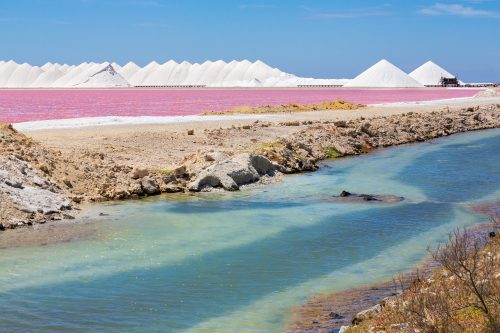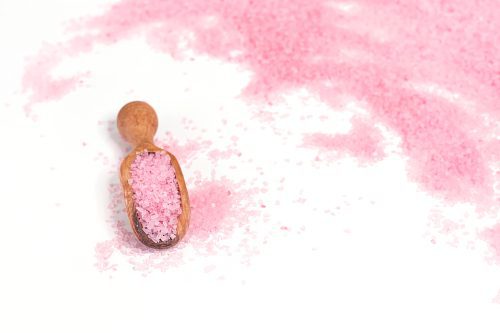Bonaire salt flats: a unique blend of industry, nature and recreation
Introduction
The Bonaire salt flats, a fascinating natural wonder and industrial powerhouse, is where pure salt production, vibrant wildlife, and thrilling diving adventures intertwine. During our first Bonaire vacation in 2007, the harmony of industry and nature on this Caribbean island truly amazed us. We went to the Cargill site and we learned a lot about the salt mining industry on Bonaire! The following comprehensive article explores the history, production process, environmental aspects, and economic impact of the Bonaire salt flats, aiming to shed light on the significance of this unique destination.
History of the Bonaire salt flats
- Early beginnings of salt production. Centuries ago, Bonaire was colonized by the Dutch, and the extraction of salt began. Salt was highly valued for its role in preserving food and facilitating trade, making it an essential commodity. The salt pans that speckle Bonaire’s landscape serve as a lasting reminder of the island’s rich history, where the extraction of salt was a vital tradition that has endured through the centuries. This mineral played a critical role in preserving food and driving commerce, and its significance can still be felt today in the form of these enduring and iconic salt pans. Employing local laborers, they manually harvested the salt in small pans across the island, mainly using the harvested salt for fish preservation.
- Cargill’s involvement. Since 1997, Cargill has been operating at the Bonaire Salt Flats, producing some of the world’s purest salts. This multinational company has modernized the salt production process, making it more efficient and sustainable than the traditional methods. Cargill’s investment in the area has resulted in a thriving industry that generates substantial revenue for the island.
- Evolution of techniques. Over the years, the salt production techniques on Bonaire have significantly evolved. Gone are the days of arduous manual labor in the process, as modern technology and the abundant natural resources have made it a streamlined and efficient system. What was once a time-consuming and demanding task has been transformed into a sophisticated operation that maximizes both output and quality.. Instead of small salt pans, Cargill uses vast crystallizers that speed up the process while reducing environmental impact. This evolution has led to the production of high-quality salt and increased global demand.

Salt production process
During our visit to the salt flats, we witnessed the fascinating production process. The process begins on Bonaire’s east coast, where the ocean water flows naturally onto the land due to wave action and gravity. As the water enters the salt flats, it is teeming with life, hosting various fish and other marine creatures. However, as the water progresses through a series of ponds, evaporation takes place, resulting in an increase in the salinity level. Consequently, the water’s color and temperature change. Due to this change in temperature, there is a shift in the organisms that reside in the water.
Finally, the highly saline water reaches the crystallizers, where the salt begins to accumulate in impressive mounds. Each year, workers drain the 16 crystallizers and harvest the salt into piles, leaving a base layer of about 15 to 20 cm of salt at the bottom of each pond. They then separate the harvested salt into three distinct grades: super coarse grade for water softeners, coarse grade for the chemical industry, and medium grade for fish preservation and other food applications.
Environmental aspects
Preserving the ecosystem is crucial, and Cargill has taken several measures to reduce the salt production’s environmental impact. One such measure is the intentional design of the salt flats to integrate with the local wildlife. In doing so, they have created an environment where birds, fish, and other creatures can thrive. Furthermore, Cargill continuously monitors the ecological balance and seeks to improve its processes to minimize the environmental footprint.

Bonaire Flamingo Sanctuary
During our visit to the Flamingo Sanctuary, situated within the salt flats, we delightedly learned about these beautiful creatures. The high salinity levels attract flamingos to the area, creating an ideal habitat for them. The flamingos themselves choose the sanctuary as a protected area, and the Bonaire government ensures the preservation of this crucial nesting site.
- Overview of the sanctuary and its purpose. The Flamingo Sanctuary is a haven for these stunning birds. It lets them nest, breed, and rear their young safely. The salt flats’ high salinity promotes growth of flamingos’ main food, like brine shrimp and blue-green algae.
- Flamingo nesting habits and life cycle. During the breeding season, both male and female flamingos work together to construct a nest that is about 10 to 12 inches high. Each nest will contain a single egg that takes approximately 28 to 32 days to hatch. Once the chick hatches, both parents are involved in caring for the young. Flamingo chicks are born with white feathers, but they gradually turn pink as they grow, thanks to a diet rich in larvae, shrimp, and algae.
- Conservation efforts to protect the flamingo population. The Bonaire government and local organizations have implemented several conservation measures to protect the flamingo population in the area. These measures include regular monitoring of the birds and their habitat, educational programs to raise awareness about flamingo conservation, and regulations to prevent disturbances to the nesting sites.
Bonaire salt pier
The salt pier, located near the salt flats, serves multiple purposes:
- Role of the salt pier in the transportation of salt. The salt pier is the primary point for transporting Bonaire salt to global markets. Large ships dock at the pier, where the salt is loaded from the massive piles located nearby. The salt pier plays a crucial role in ensuring that the high-quality salt produced at the flats reaches consumers worldwide.
- Importance as a diving site. The salt pier serves as a popular diving site, drawing scuba enthusiasts globally. The underwater area boasts sponges, corals, and marine life in nutrient-rich waters. Divers can encounter tropical fish, sea turtles, octopuses, and eels. The calm, clear waters offer excellent visibility, making it a sought-after diving destination.
- Recognition as the best shore diving destination. Scuba Diving Magazine has designated Bonaire as the best shore diving destination for over two decades. The salt pier, with its fascinating underwater world, plays a significant role in earning this prestigious title.

Economic impact of the Bonaire salt flats
The salt production industry plays a significant role in Bonaire’s economy, providing jobs for local residents and contributing to the island’s overall prosperity. The high-quality salt produced at the flats is in high demand worldwide, creating a valuable export product for the island.
The salt industry generates much of Bonaire’s revenue. This leads to better infrastructure, education, and healthcare for locals. Additionally, the industry’s success attracts tourism. It also encourages recreational activities around the salt flats, boosting the economy further.
Expert insights
During our trip in 2007, we met professionals who shared their insights. They informed us about the importance of sustainability and ecological balance in the salt production process. They emphasized the need for continuous monitoring and improvement to ensure that the industry thrives without compromising the local ecosystem. Additionally, environmental scientists shed light on the importance of conservation efforts and their positive impact on Bonaire’s unique flora and fauna.

Conclusion
The Bonaire salt flats represents a delicate balance between industry, nature, and recreation, making it a must-see destination for visitors seeking an extraordinary experience
A trip to the salt pans is not just an opportunity to witness the production of some of the world’s purest salt. It is also a chance to immerse oneself in the island’s diverse ecosystem and partake in thrilling recreational activities.
The pans truly embody the harmonious coexistence of industry, nature, and recreation. With its rich history, stunning landscapes, and unique wildlife, this destination offers a memorable and educational experience for travelers seeking to explore the hidden gems of the Caribbean. So, pack your bags and embark on an unforgettable adventure to the captivating salt flats.